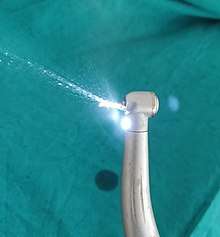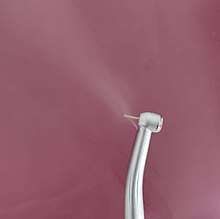Dental aerosol
A dental aerosol is an aerosol that is produced from dental instrument, dental handpieces, three-way syringes and other high-speed instruments. These aerosols are air suspended in the clinical environment.[1] These aerosols can pose risks to the clinician, staff and other patients as well. The heavier particles (>50 µm ) of the aerosols suspend in the air for relatively short period and settles down quickly, but the lighter particles tend to remain suspended for longer periods and are capable to enter and get deposited in the lungs when they are inhaled and possess the capacity of transmitting diseases.[2]


Composition
These dental aerosols are also bioaerosols which are contaminated with bacteria, fungi and viruses of the oral cavity, skin and the water used in the dental units.[3] Dental aerosols also have micro-particles of the burs, and silica particles which are one of the components of dental filling materials like dental composite.[4] Depending upon the procedure and site, the aerosol composition may change from patient to patient. Apart from microorganisms, these aerosols may consist of particles from saliva, blood, dental plaque, calculus, tooth debris, oronasal secretions, gingival fluids, and micro-particles from grinding of the teeth.[5] They also consist of abrasive particles that are expelled during air abrasion and polishing methods.[2]
Size
The size of the dental aerosol particles is less than 50 µm. The smaller particles with size between 0.5 µm -10 µm are more likely to be inhaled and have the potential to transmit the infections.[2]
Potential hazards
The water used in the dental units may be contaminated with Legionella, the aerosols from the hand-pieces of such dental units may lead to the spread of the Legionella in the environment of the dental setting which possibly leads to the inhalation by the dentist, staff and patients.[6] The dental unit water lines (DUWLs) may also be contaminated with other bacteria like Mycobacterium spp and Pseudomonas aeruginosa.[7] Infection from Legionella species causes infections like Legionellosis and several pneumonia like diseases.[8] However, still there is no strong evidence that suggests the dentists are at greater occupational risk from Legionella.[6] Transmission of tuberculosis also occurs from the cough producing procedures on the patients with tuberculosis that involve production of aerosols.[9] Mycobacterium tuberculosis is transmitted in the form of droplet nuclei which are smaller than 5 µm which stay suspended in the environment for longer duration. The development of active tuberculosis in Dental Health Care Workers (DHCWs) is less likely than the rest of the other Health Care Workers (HCWs). There are lacking evidences to prove the active tuberculosis development resulting from this transmission in Dental health care Workers (DHCWs).[10]
The virus that caused the COVID-19 pandemic is named as severe acute respiratory syndrome coronavirus 2 (SARS-CoV-2) by the International Committee on Taxonomy of Viruses (ICTV) on 11 February 2020.[11] SARS-CoV-2 remains stable in aerosols for several hours.[12] The virus is viable for hours in aerosols and for few days on surfaces, hence the transmission of SARS-CoV-2 is feasible through aerosols and also shows fomite transmission.[13]
Dentists are at the top of the working groups who have a high risk of exposure to SARS-CoV-2. Due to the close proximity of the dental health care workers to the patients, dental procedures involving aerosol production is not advisable in patients who tested positive for COVID-19.[14] On 16 March 2020, the American Dental Association (ADA) has advised dentists to postpone all elective procedures.[15] ADA also developed guidance specific to address dental services during the COVID-19 pandemic.[16]
Elements like calcium, aluminium, silica and phosphorus can also be found in the dental aerosols produced during the procedures like debonding of orthodontic appliances.[17] These particles may range from 2 to 30 µm in diameter and there are chances of inhaling them.[18]
References
- Chuang, Chi-Yu; Cheng, Hsin-Chung; Yang, Shinhao; Fang, Wei; Hung, Po-Chen; Chuang, Sheng-Yen (2014). "Investigation of the spreading characteristics of bacterial aerosol contamination during dental scaling treatment". Journal of Dental Sciences. 9 (3): 294–296. doi:10.1016/j.jds.2014.06.002.
- Harrel, Stephen K.; Molinari, John (2004-04-01). "Aerosols and splatter in dentistry: A brief review of the literature and infection control implications". The Journal of the American Dental Association. 135 (4): 429–437. doi:10.14219/jada.archive.2004.0207. ISSN 0002-8177. PMC 7093851. PMID 15127864.
- Zemouri, Charifa; de Soet, Hans; Crielaard, Wim; Laheij, Alexa (2017-05-22). Zhou, Dongsheng (ed.). "A scoping review on bio-aerosols in healthcare and the dental environment". PLOS ONE. 12 (5): e0178007. Bibcode:2017PLoSO..1278007Z. doi:10.1371/journal.pone.0178007. ISSN 1932-6203. PMC 5439730. PMID 28531183.
- Sivakumar, Indumathi; Arunachalam, Kuthalingam Subbiah; Solomon, Egr (2012). "Occupational health hazards in a prosthodontic practice: review of risk factors and management strategies". The Journal of Advanced Prosthodontics. 4 (4): 259–65. doi:10.4047/jap.2012.4.4.259. ISSN 2005-7806. PMC 3517967. PMID 23236581.
- King, Tracy B.; Muzzin, Kathleen B.; Berry, Charles W.; Anders, Lisa M. (1997). "The Effectiveness of an Aerosol Reduction Device for Ultrasonic Sealers". Journal of Periodontology. 68 (1): 45–49. doi:10.1902/jop.1997.68.1.45. ISSN 1943-3670. PMID 9029451.
- Petti, Stefano; Vitali, Matteo (2017). "Occupational risk forLegionellainfection among dental healthcare workers: meta-analysis in occupational epidemiology". BMJ Open. 7 (7): e015374. doi:10.1136/bmjopen-2016-015374. ISSN 2044-6055. PMC 5734417. PMID 28710211.
- "WHO | Water safety in buildings". WHO. Retrieved 2020-03-13.
- Legionella and the prevention of legionellosis. World Health Organization. 2007.
- "Guidelines for Preventing the Transmission of Mycobacterium tuberculosis in Health-Care Settings, 2005". www.cdc.gov. Retrieved 2020-03-16.
- Petti, Stefano (2016). "Tuberculosis: Occupational risk among dental healthcare workers and risk for infection among dental patients. A meta-narrative review". Journal of Dentistry. 49: 1–8. doi:10.1016/j.jdent.2016.04.003. ISSN 0300-5712. PMID 27106547.
- "Naming the coronavirus disease (COVID-19) and the virus that causes it". www.who.int. Retrieved 2020-03-19.
- "New coronavirus stable for hours on surfaces". National Institutes of Health (NIH). 2020-03-17. Retrieved 2020-03-19.
- Doremalen, Neeltje van; Bushmaker, Trenton; Morris, Dylan H.; Holbrook, Myndi G.; Gamble, Amandine; Williamson, Brandi N.; Tamin, Azaibi; Harcourt, Jennifer L.; Thornburg, Natalie J. (2020-03-17), "Aerosol and Surface Stability of SARS-CoV-2 as Compared with SARS-CoV-1", New England Journal of Medicine (letter), 382 (16): 1564–1567, doi:10.1056/nejmc2004973, PMC 7121658, PMID 32182409
- Gamio, Lazaro (2020-03-15). "The Workers Who Face the Greatest Coronavirus Risk". The New York Times. ISSN 0362-4331. Retrieved 2020-03-16.
- "ADA Calls Upon Dentists to Postpone Elective Procedures". American Dental Association. 16 March 2020. Retrieved 23 March 2020.
- "COVID-19 Resources for Dentists". American Dental Association. Retrieved 23 March 2020.
- Day, Christian J.; Price, Robert; Sandy, Jonathan R.; Ireland, Anthony J. (2008). "Inhalation of aerosols produced during the removal of fixed orthodontic appliances: A comparison of 4 enamel cleanup methods". American Journal of Orthodontics and Dentofacial Orthopedics. 133 (1): 11–17. doi:10.1016/j.ajodo.2006.01.049. ISSN 0889-5406. PMID 18174065.
- Ireland, Anthony J; Moreno, Teresa; Price, Robert (2003). "Airborne particles produced during enamel cleanup after removal of orthodontic appliances". American Journal of Orthodontics and Dentofacial Orthopedics. 124 (6): 683–686. doi:10.1016/s0889-5406(03)00623-1. ISSN 0889-5406. PMID 14666082.